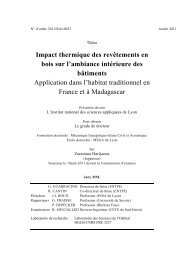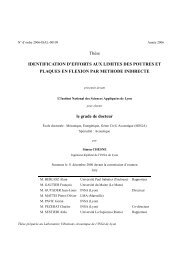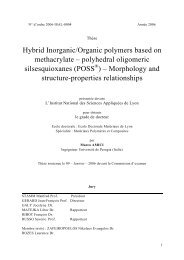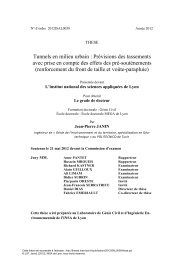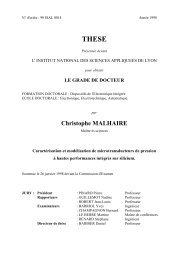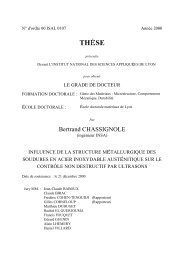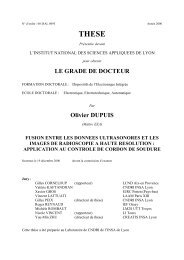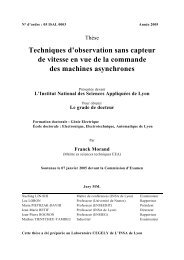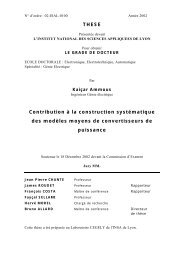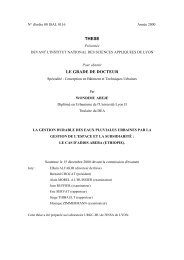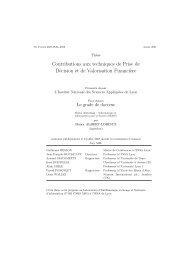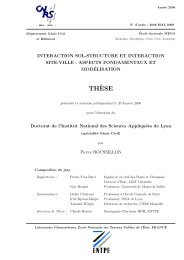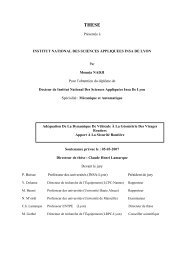Caractérisation en compression simple des blocs de terre comprimée
Caractérisation en compression simple des blocs de terre comprimée
Caractérisation en compression simple des blocs de terre comprimée
You also want an ePaper? Increase the reach of your titles
YUMPU automatically turns print PDFs into web optimized ePapers that Google loves.
Résumé<br />
Les maçonneries <strong>en</strong> BTC (Blocs <strong>de</strong> Terre Comprimée) permett<strong>en</strong>t <strong>de</strong> construire <strong><strong>de</strong>s</strong> habitats individuels à un<br />
faible coût <strong>en</strong>vironnem<strong>en</strong>tal (et économique pour les pays du sud) car on utilise <strong><strong>de</strong>s</strong> matériaux locaux. De plus<br />
cette démarche a un impact socioéconomique positif puisqu'elle favorise le travail humain direct <strong>de</strong> construction<br />
contrairem<strong>en</strong>t à la filière actuelle basée sur l'industrialisation <strong>de</strong> la production du matériau. L'architecture utilisée<br />
est adaptée au matériau qui ne doit travailler qu'<strong>en</strong> <strong>compression</strong>.<br />
Cette thèse s'inscrit dans un contexte <strong>de</strong> formalisation du comportem<strong>en</strong>t <strong>en</strong> <strong>compression</strong> <strong><strong>de</strong>s</strong> maçonneries <strong>en</strong><br />
BTC. Nous avons pour cela effectué une étu<strong>de</strong> <strong>de</strong> comportem<strong>en</strong>t <strong><strong>de</strong>s</strong> maçonneries <strong>en</strong> BTC sous <strong>compression</strong><br />
<strong>simple</strong> verticale. Le BTC est la composante principale <strong>de</strong> la maçonnerie. Ainsi une analyse <strong>de</strong> son comportem<strong>en</strong>t<br />
<strong>en</strong> <strong>compression</strong> <strong>simple</strong> est faite. Les différ<strong>en</strong>tes procédures d'essais <strong>de</strong> <strong>compression</strong> utilisées jusqu'à maint<strong>en</strong>ant<br />
sur BTC sont prés<strong>en</strong>tées et critiquées. Nous arrivons à la conclusion que l'essai sur <strong>de</strong>mis <strong>blocs</strong> maçonnés (l'un<br />
au <strong><strong>de</strong>s</strong>sus <strong>de</strong> l'autre) est pertin<strong>en</strong>t. Il est aussi démontré que l'essai <strong>de</strong> flexion <strong>en</strong> trois points peut donner la<br />
résistance <strong>en</strong> <strong>compression</strong> <strong>de</strong> BTC avec une précision <strong>de</strong> l'ordre <strong>de</strong> 20%. La secon<strong>de</strong> composante <strong>de</strong> la<br />
maçonnerie est le mortier <strong>de</strong> <strong>terre</strong> (à plus <strong>de</strong> 88% <strong>en</strong> poids sec <strong>de</strong> <strong>terre</strong>) stabilisé au cim<strong>en</strong>t. La littérature<br />
n'apporte que peu d'information sur ces mortiers à forte t<strong>en</strong>eur d'argile (<strong>en</strong>tre 5 et 20% d'argile). Nous faisons un<br />
bilan <strong><strong>de</strong>s</strong> procédures d'essais appropriés à ces types <strong>de</strong> mortier. Il <strong>en</strong> ressort l'impossibilité d'utiliser le<br />
maniabilimètre AFNOR, la possibilité d'utiliser le cône d'Abrams et la nécessité d'appréh<strong>en</strong><strong>de</strong>r le comportem<strong>en</strong>t<br />
d'interface BTC-mortier. Enfin <strong><strong>de</strong>s</strong> échantillons <strong>de</strong> maçonnerie <strong>de</strong> formulations différ<strong>en</strong>tes, d'<strong>en</strong>viron 1m 2 <strong>de</strong><br />
surface et <strong><strong>de</strong>s</strong> triplets <strong>de</strong> BTC maçonnés avec du mortier <strong>de</strong> <strong>terre</strong> sont testés <strong>en</strong> <strong>compression</strong> <strong>simple</strong>. Une<br />
différ<strong>en</strong>ce <strong>de</strong> 38% au maximum <strong><strong>de</strong>s</strong> résistances <strong>en</strong> <strong>compression</strong> <strong>en</strong>tre ces 2 types d'échantillons a été observée.<br />
Par ailleurs, l'application <strong>de</strong> la formule <strong>de</strong> l'Euroco<strong>de</strong> 6 (EC6) relative aux maçonneries conv<strong>en</strong>tionnelles<br />
conduit, d'une manière générale, à la sous estimation <strong>de</strong> la résistance <strong>en</strong> <strong>compression</strong> <strong><strong>de</strong>s</strong> maçonneries BTC<br />
par rapport aux valeurs expérim<strong>en</strong>tales. Les rapports <strong>en</strong>tre la résistance à la rupture calculée par la formule EC6<br />
et la valeur expérim<strong>en</strong>tale vari<strong>en</strong>t <strong>en</strong>tre 44 et 72%.<br />
Abstract<br />
Compressed earth blocks (CEB) masonry make it possible to build individual houses at a low <strong>en</strong>vironm<strong>en</strong>tal<br />
(and economic for poor countries) cost because of the use of local materials. Moreover, this step has a positive<br />
social and economic impact since it supports the direct human work of construction, contrary to the curr<strong>en</strong>t type<br />
of construction based on the industrialization of the material production.<br />
Architecture used in CEB construction is adapted to a material which should support only <strong>compression</strong> stress.<br />
This thesis is a contribution to the formalization of CEB masonries buildings <strong><strong>de</strong>s</strong>ign which concerns, until now,<br />
only the co<strong>de</strong> of practice. Only masonry behaviour un<strong>de</strong>r vertical <strong>compression</strong> load is analysed.<br />
As a preliminary, the CEB which constitute the principal compon<strong>en</strong>t of masonry were studied. The various<br />
<strong>compression</strong> tests used for CEB were pres<strong>en</strong>ted and criticized. Compression test on two half built blocks<br />
remains relevant. It was shown that three points b<strong>en</strong>ding test can also give compressive str<strong>en</strong>gth of CEB.<br />
The second compon<strong>en</strong>t of masonry is earth mortar stabilized with cem<strong>en</strong>t. There exists very little information<br />
on these mortars with strong clay cont<strong>en</strong>t (betwe<strong>en</strong> 5 and 20 % and more). An overview of mortar tests able to<br />
be used for earth mortar is ma<strong>de</strong> and lead to some propositions for future studies. Finally, two types masonry<br />
samples were tested un<strong>de</strong>r vertical <strong>compression</strong> load ; 1m 2 masonry and three blocks bpn<strong>de</strong>d samples. The<br />
Euroeo<strong>de</strong> 6 formula for masonry compressive str<strong>en</strong>gth assessm<strong>en</strong>t is used and the results compared with our.<br />
experim<strong>en</strong>tal data.



